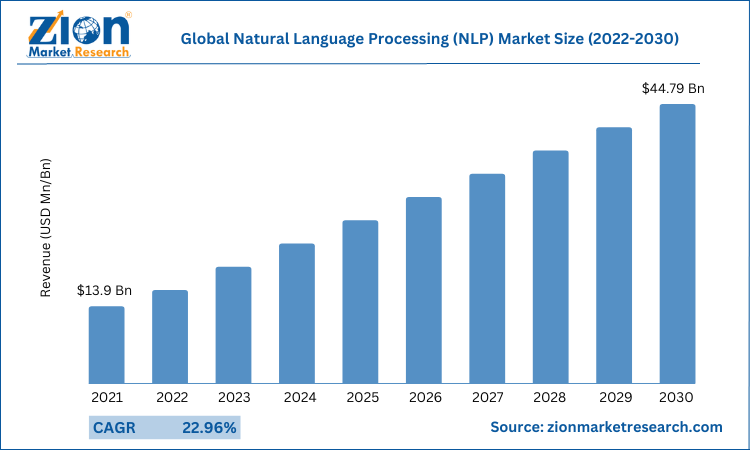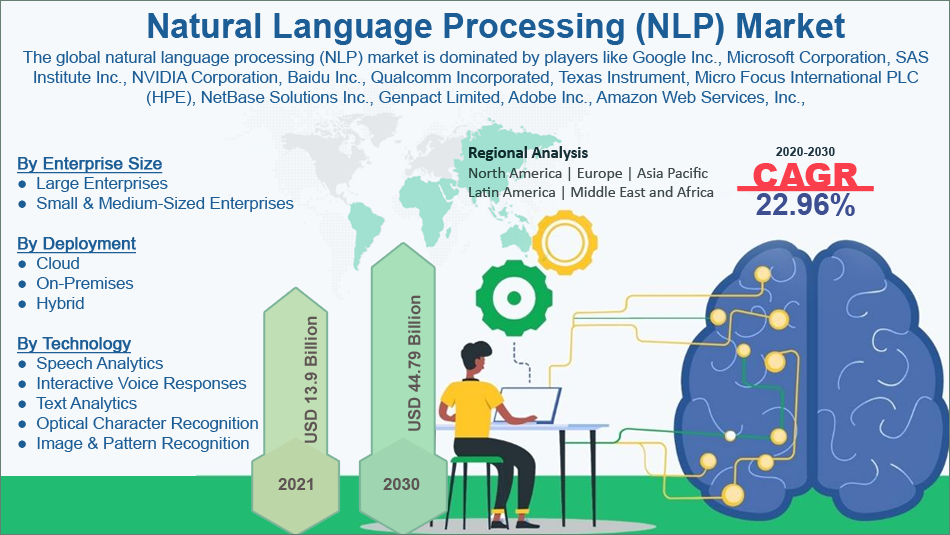Natural Language Processing (NLP) Market Size, Share, Trends and Forecast 2034

Natural Language Processing (NLP) Market By Component (Solution, Services), By Deployment (Cloud, On-Premises), By Enterprise Size (Large Enterprises, Small & Medium Enterprises), By Type (Statistical NLP, Rule Based NLP, Hybrid NLP), By Application (Sentiment Analysis, Data Extraction, Risk And Threat Detection, Automatic Summarization, Content Management, Language Scoring, Others (Portfolio Monitoring, HR & Recruiting, And Branding & Advertising)), By End-use (BFSI, IT & Telecommunication, Healthcare, Education, Media & Entertainment, Retail & E-commerce, Others), and By Region: Global and Regional Industry Overview, Market Intelligence, Comprehensive Analysis, Historical Data, and Forecasts 2025 - 2034
| Market Size in 2024 | Market Forecast in 2034 | CAGR (in %) | Base Year |
|---|---|---|---|
| USD 25.90 Billion | USD 206.32 Billion | 23.06% | 2024 |
Natural Language Processing (NLP) Market: Industry Perspective
The global natural language processing (NLP) market size was worth around USD 25.90 Billion in 2024 and is predicted to grow to around USD 206.32 Billion by 2034 with a compound annual growth rate (CAGR) of roughly 23.06% between 2025 and 2034. The report analyzes the global natural language processing (NLP) market's drivers, restraints/challenges, and the effect they have on the demands during the projection period. In addition, the report explores emerging opportunities in the natural language processing (NLP) industry.
Natural Language Processing (NLP) Market: Overview
Natural language processing (NLP) is a segment of artificial intelligence (AI) in the computer science industry. It deals with providing computers with the necessary tools or the capability to listen and understand spoken words or texts in a way that another human being can interpret or understand.
It works with the combination of computational linguistics with other advanced systems like deep learning, machine learning, and statistical models. When these technologies work in synchronization, they can process human language, either in voice or text format, and understand it completely along with acknowledging the speaker’s emotion or intention.
NPL runs programs that can efficiently translate a given text from one language to another while also assisting in summarizing high volumes of the largest texts rapidly along with generating sensible responses to any command. NLP systems have already created a space for themselves in everyday lives in the form of digital assistance, voice-operated global positioning systems, or chatbots used by customer service teams of many organizations.
Key Insights
- As per the analysis shared by our research analyst, the global natural language processing (NLP) market is estimated to grow annually at a CAGR of around 23.06% over the forecast period (2025-2034).
- Regarding revenue, the global natural language processing (NLP) market size was valued at around USD 25.90 Billion in 2024 and is projected to reach USD 206.32 Billion by 2034.
- The natural language processing (NLP) market is projected to grow at a significant rate due to growing use in customer service and data analysis, and the increasing volume of unstructured text data.
- Based on Component, the Solution segment is expected to lead the global market.
- On the basis of Deployment, the Cloud segment is growing at a high rate and will continue to dominate the global market.
- Based on the Enterprise Size, the Large Enterprises segment is projected to swipe the largest market share.
- By Type, the Statistical NLP segment is expected to dominate the global market.
- In terms of Application, the Sentiment Analysis segment is anticipated to command the largest market share.
- On the basis of End-use, the BFSI segment is expected to dominate the global market.
- Based on region, North America is predicted to dominate the global market during the forecast period.
To know more about this report, Request a sample copy
Natural Language Processing (NLP) Market: Growth Drivers
Growing applications in developing smart assistants to propel market demand
The global natural language processing (NLP) market is projected to grow owing to the rising applications of AI in the development of smart assistants that have become a common part of the everyday lives of the general population. Smart assistants like Alexa, developed by Amazon, or Siri by Apple are prime examples of how NLP is currently being leveraged by technology companies to provide an improved consumer experience. Another prime example of NLP use in every task is to obtain relevant search data without having to type the entire query on the search section of a browser.
Google can now predict and automatically type the entire query in its search dialogue once the user types a few words related to the question. The current search options are highly optimized since all a user needs to input are a few logical words and the application will automatically predict the entire question and deliver optimum results. Furthermore, the growing use of NLP in data analysis workflows could act as the global market driver during the projection period.
Natural Language Processing (NLP) Market: Restraints
Inaccuracy in speech or text to restrict market expansion
One of the major growth restraints for the natural language processing industry players is related to achieving essential accuracy in cases where there are misused or misspelled words from the user’s end. Such issues can have a drastic impact on the final text analysis and response. Although grammar correcting applications or autocorrect may resolve the issue of misspelled words, the chances of the system not being able to understand the intention of the writer are really high.
Natural Language Processing (NLP) Market: Opportunities
Growing research & product innovation to provide growth opportunities
The global natural language processing market is anticipated to register high growth opportunities owing to the rising investment in product development and innovation along with the increasing launch of supportive tools that can help the NLP technologies perform better. Companies working in the segment are working toward developing advanced versions of existing systems that can conduct higher levels of text classification, sentiment analysis, auto-correction, and other essential features. Additionally, the growing reliance on technical giants like Amazon and Google could lead to higher investments in the coming years, especially in voice recognition intelligence.
Natural Language Processing (NLP) Market: Challenges
Lack of skilled professionals to challenge the market expansion
NLP’s are extremely complex to program and develop owing to a large number of natural languages each with its set of syntax rules. The ambiguity of words makes undertaking language even more difficult. The natural language processing industry is currently witnessing a significant gap in the supply and demand of skilled professionals that can help companies meet the vision for the advanced versions of NLP.
Natural Language Processing (NLP) Market: Segmentation Analysis
The global natural language processing (NLP) market is segmented based on Component, Deployment, Enterprise Size, Type, Application, End-use, and region.
Based on Component, the global natural language processing (NLP) market is divided into Solution, Services.
On the basis of Deployment, the global natural language processing (NLP) market is bifurcated into Cloud, On-Premises.
By Enterprise Size, the global natural language processing (NLP) market is split into Large Enterprises, Small & Medium Enterprises.
In terms of Type, the global natural language processing (NLP) market is categorized into Statistical NLP, Rule Based NLP, Hybrid NLP.
By Application, the global Natural Language Processing (NLP) market is divided into Sentiment Analysis, Data Extraction, Risk And Threat Detection, Automatic Summarization, Content Management, Language Scoring, Others (Portfolio Monitoring, HR & Recruiting, And Branding & Advertising).
On the basis of End-use, the global Natural Language Processing (NLP) market is divided into BFSI, IT & Telecommunication, Healthcare, Education, Media & Entertainment, Retail & E-commerce, Others.
Recent Developments:
- In October 2022, John Snow Labs, an AI and NLP for a healthcare company announced the launch of two NLPs namely Legal NLP and Finance NLP. The new products or libraries are equipped with a state-of-the-art algorithm and new pre-trained models that can conduct Relation Extraction, Entity Recognition, Entity Resolution, Assertion Status Detection, Text Classification, and other activities
- In May 2022, One AI Inc., a recent entrant in the market, announced its launch with a funding of USD 8 million. The company works with natural language processing technology while the funding was provided by various known technology investors
Natural Language Processing (NLP) Market: Report Scope
| Report Attributes | Report Details |
|---|---|
| Report Name | Natural Language Processing (NLP) Market |
| Market Size in 2024 | USD 25.90 Billion |
| Market Forecast in 2034 | USD 206.32 Billion |
| Growth Rate | CAGR of 23.06% |
| Number of Pages | 190 |
| Key Companies Covered | Google Inc., Microsoft Corporation, SAS Institute Inc., NVIDIA Corporation, Baidu Inc., Qualcomm Incorporated, Texas Instrument, Micro Focus International PLC (HPE), NetBase Solutions Inc., Genpact Limited, Adobe Inc., Amazon Web Services, Inc., 3M, Inbenta, Meta Platforms Inc., IQVIA, Crayon Data, Facebook, Hewlett-Packard Enterprise, Apple Inc., Intel Corporation, Narrative Science, Verint Systems, Inc., and IBM Corporation., and others. |
| Segments Covered | By Component, By Deployment, By Enterprise Size, By Type, By Application, By End-use, and By Region |
| Regions Covered | North America, Europe, Asia Pacific (APAC), Latin America, The Middle East and Africa (MEA) |
| Base Year | 2024 |
| Historical Year | 2020 to 2024 |
| Forecast Year | 2025 to 2034 |
| Customization Scope | Avail customized purchase options to meet your exact research needs. Request For Customization |
Natural Language Processing (NLP) Market: Regional Analysis
North America to lead with the highest CAGR
The global natural language processing (NLP) market is projected to be led by North America during the forecast period, majorly driven by the already existing dominant consumer and provider database in the regions of the US and Canada. The former is home to some of the biggest names working in the global market operating at the multi-regional level and constantly using NLP technologies to upgrade associated systems along with innovating the technology itself for further use.
The growth in the number of small and mid-size players leveraging the advantages of NLP like makers of autocorrect applications, chatbots, and other segments could further drive regional growth. Growth in Europe is anticipated to be driven by the growing adoption of AI technologies coupled with machine learning across the industrial sector, especially driven by the regional marketing and advertising sector. During the projection period, the region’s digital marketing sector is expected to grow at a CAGR of 8.6%.
Natural Language Processing (NLP) Market: Competitive Analysis
The report provides a company market share analysis to give a broader overview of the key market players. In addition, the report also covers key strategic developments of the market, including acquisitions & mergers, new product launches, agreements, partnerships, collaborations & joint ventures, research & development, and regional expansion of major participants involved in the natural language processing (NLP) market on a global and regional basis.
The global natural language processing (NLP) market is dominated by players like:
- Google Inc.
- Microsoft Corporation
- SAS Institute Inc.
- NVIDIA Corporation
- Baidu Inc.
- Qualcomm Incorporated
- Texas Instrument
- Micro Focus International PLC (HPE)
- NetBase Solutions Inc.
- Genpact Limited
- Adobe Inc.
- Amazon Web Services Inc.
- 3M
- Inbenta
- Meta Platforms Inc.
- IQVIA
- Crayon Data, Facebook
- Hewlett-Packard Enterprise
- Apple Inc.
- Intel Corporation
- Narrative Science
- Verint Systems Inc.
- IBM Corporation.
The global natural language processing (NLP) market is segmented as follows:
By Industry Vertical
- Retail
- Healthcare
- Banking
- High Tech & Telecom
- Automotive & Transportation
- Financial Services
- Manufacturing, Media
- Others
By Enterprise Size
- Large Enterprises
- Small & Medium-Sized Enterprises
By Deployment
- Cloud
- On-Premises
- Hybrid
By Technology
- Speech Analytics
- Interactive Voice Responses
- Text Analytics
- Optical Character Recognition
- Image & Pattern Recognition
By Region
- North America
- The U.S.
- Canada
- Europe
- France
- The UK
- Spain
- Germany
- Italy
- Rest of Europe
- Asia Pacific
- China
- Japan
- India
- South Korea
- Southeast Asia
- Rest of Asia Pacific
- Latin America
- Brazil
- Mexico
- Rest of Latin America
- Middle East & Africa
- GCC
- South Africa
- Rest of Middle East & Africa
Table Of Content
Methodology
FrequentlyAsked Questions
The global natural language processing (NLP) market is expected to grow due to growing use in customer service and data analysis, and the increasing volume of unstructured text data.
According to a study, the global natural language processing (NLP) market size was worth around USD 25.90 Billion in 2024 and is expected to reach USD 206.32 Billion by 2034.
The global natural language processing (NLP) market is expected to grow at a CAGR of 23.06% during the forecast period.
North America is expected to dominate the natural language processing (NLP) market over the forecast period.
Leading players in the global natural language processing (NLP) market include Google Inc., Microsoft Corporation, SAS Institute Inc., NVIDIA Corporation, Baidu Inc., Qualcomm Incorporated, Texas Instrument, Micro Focus International PLC (HPE), NetBase Solutions Inc., Genpact Limited, Adobe Inc., Amazon Web Services, Inc., 3M, Inbenta, Meta Platforms Inc., IQVIA, Crayon Data, Facebook, Hewlett-Packard Enterprise, Apple Inc., Intel Corporation, Narrative Science, Verint Systems, Inc., and IBM Corporation., among others.
RelatedNews
HappyClients
Zion Market Research
Tel: +1 (302) 444-0166
USA/Canada Toll Free No.+1 (855) 465-4651
3rd Floor,
Mrunal Paradise, Opp Maharaja Hotel,
Pimple Gurav, Pune 411061,
Maharashtra, India
Phone No +91 7768 006 007, +91 7768 006 008
US OFFICE NO +1 (302) 444-0166
US/CAN TOLL FREE +1 (855) 465-4651
Email: sales@zionmarketresearch.com
We have secured system to process your transaction.
Our support available to help you 24 hours a day, five days a week.
Monday - Friday: 9AM - 6PM
Saturday - Sunday: Closed







